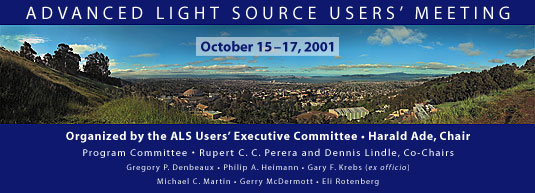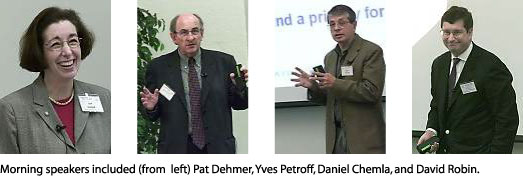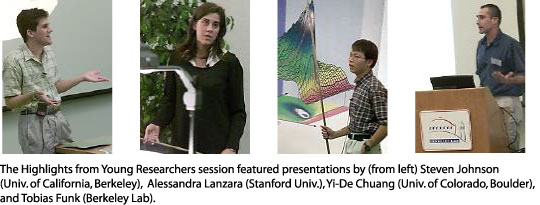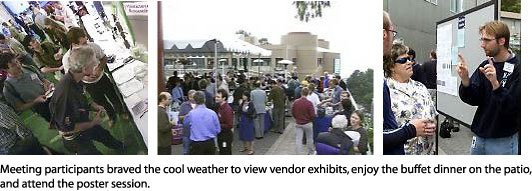
2001 ALS Users' Meeting Highlights
Sponsored by the Users' Executive Committee (UEC) and spread over three days from October 15-17, the annual ALS Users' Meeting featured an exceptional program with quality science as the main theme. While the first day was reserved for the traditional facility and Washington reports and for science highlights, the following two days, devoted to several workshops covering topics from theory to detectors, new experimental facilities, and forefront science, were strong draws. As a result, it should not be surprising that the number of registered attendees jumped to a record level of 352, more than 100 above the typical attendance in recent years. The arrival of superconducting bend magnets, or superbends, just before the meeting opened also helped stimulate interest.
|
After a brief introduction by Roger Falcone (Univ. of California, Berkeley), the incoming UEC chair for 2002, Berkeley Lab Director Charles Shank began the Monday morning update session by looking forward to the considerable scientific impact expected for the new superbend era. Patricia Dehmer, U.S. Department of Energy Associate Director for Basic Energy Sciences (BES), pointedly noted that ALS funding was up in an era of flat BES budgets and also called attention to the adaptations required if an institution is to thrive in a changing world. Among many topics in his detailed facility report, ALS Director Daniel Chemla highlighted the complementary roles of Yves Petroff (Senior Advisor on sabbatical from the European Synchrotron Radiation Facility) and Neville Smith (ALS Deputy for Science) in a reassessment of facility policies, procedures, and organizational structure to optimize resources and productivity. |
||

|
||
|
David Robin, ALS Accelerator Physics Group Leader, reported on the many challenges met and overcome in installing and commissioning the superbends ahead of a tight schedule while meeting or exceeding performance specifications. Outgoing UEC Chair Harald Ade (North Carolina State Univ.) conducted a user town meeting in which he explained the many ways in which the UEC contributes to ALS planning, introduced the new electronic voting system, and summarized interactions with Congress in collaboration with the UECs of other synchrotron sources. Michael Lubell (Director of Public Affairs, American Physical Society) concluded the update session with a review of the changes in Washington brought on by the soft economy and the new war on terrorism, contributing to which is becoming the top priority for federally funded science. |
||
|
Commencing a series of three sessions on science highlights at the ALS and highlights from young researchers, Petroff presented preliminary results of his investigation of ALS operations and scientific productivity, calling favorable attention to many areas of technical and scientific success. He also recommended increasing support for users, lowering the cost of experimental facilities, use of standardization and automation, continuing past successes with industrial beamlines, prioritizing research areas, making time for in-house research by ALS staff, and more cooperation with the Stanford Synchrotron Radiation Laboratory (SSRL). |
||

|
||
| In a notable departure from past practice, the organizers replaced the usual conference banquet with an outdoor buffet on the ALS patio and, with the aid of generous instrument vendors, provided enough food and beverages that few noticed the chilly fog. At the end of the buffet, Ade, assisted by program committee co-chairs Dennis Lindle (Univ. of Nevada, Las Vegas) and Rupert Perera (Berkeley Lab Center for X-Ray Optics), presented awards for science and service. Gary Mitchell and Ed Rightor (Dow Chemical Company) received the David A. Shirley Award for Science at the ALS for their research on super absorbent polymers (ALSNews Vol. 172). David Robin, representing the superbend team of scientists, engineers, and technicians (ALSNews Vol. 185), accepted the Halbach Award for Outstanding Instrumentation. Hendrik Olhdag (SSRL and ALS) and Christoph Bostedt (Lawrence Livermore National Laboratory and ALS) split the student poster award. The Tim Renner User Services Award was also divided, with Elke Arenholz (ALS Scientific Support Group) and Ken Barat (Berkeley Lab laser safety officer) the two winners. Greg Vierra (ALS Technical Information Section) was also recognized for creating the design used on the T-shirt and the meeting booklet. | ||

|
||
ALS Users' Meeting
Highlights
General Information :: Program
:: Workshops :: Abstract
Submission :: Registration :: Accommodation
Exhibitor
Information :: Transportation
Last updated October
30, 2001
Questions and Comments
Privacy and Security Notice